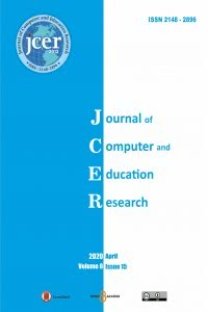The Current Trend in Educational Neuroscience Research: A Descriptive and Bibliometric Study
Educational neuroscience, neuroimaging, EEG, bibliometric analysis
The Current Trend in Educational Neuroscience Research: A Descriptive and Bibliometric Study
educational neuroscience, neuroimaging, EEG, bibliometric analysis,
___
- Ansari, D., Coch, D., & De Smedt, B. (2011). Connecting education and cognitive neuroscience: Where will the journey take us?. Educational philosophy and theory, 43(1), 37-42. https://doi.org/10.1111/j.1469-5812.2010.00705.x
- Çakmak, E. K. (2007). The bottle neck in multimedia: Cognitive overload. Gazi University Gazi The Journal of Educational Faculty, 27(2), 1-24. http://www.gefad.gazi.edu.tr/en/pub/issue/6750/90766
- Deryakulu, D., Atal, D., ve Sancar, R. (2019). Eğitimsel sinirbilim ve eğitim teknolojisi açısından doğurguları. (Editörler: A. İşman, H. F. Odabaşı ve B. Akkoyunlu). Eğitim Teknolojileri Okumaları 2019 içinde (ss. 331-348). Pegem Akademi.
- Duman, B. (2015). Neden beyin temelli öğrenme? Pegem Akademi.
- Dündar, S., (2013). The investigation of students' brain waves in the problem solving process (Unpublished Doctoral Dissertation). Gazi University.
- Feiler, J. B., & Stabio, M. E. (2018). Three pillars of educational neuroscience from three decades of literature. Trends in neuroscience and education, 13, 17-25. https://doi.org/10.1016/j.tine.2018.11.001
- Ferrari, M. (2011). What can neuroscience bring to education?. Educational Philosophy and Theory, 43(1), 31-36. https://doi.org/10.1111/j.1469-5812.2010.00704.x
- Gürlen, E., Özdiyar, Ö., & Şen, Z. (2018). Social network analysis of academic studies on gifted people. Education and Science, 44(197), 185-208. http://dx.doi.org/10.15390/EB.2018.7735
- İkiz, Y. D. (2021). An investigation of cognitive load effect using augmented reality glasses in an automotive assembly line (Unpublished Master Dissertation). Bursa Uludağ University.
- Koçak, G. (2020). Reflections of brain researches to education: Toward education of future. Yeditepe University the Journal of Educational Faculty, 9(11), 1-16. https://dergipark.org.tr/tr/pub/edu7/issue/59006/731860
- Morshad, S., Mazumder, M. R., & Ahmed, F. (2020, January). Analysis of brain wave data using Neurosky Mindwave Mobile II. In Proceedings of the International Conference on Computing Advancements (pp. 1-4). https://doi.org/10.1145/3377049.3377053
- Sweller, J. (2004). Instructional design consequences of an analogy between evolution by natural selection and human cognitive architecture. Instructional Science, 32, 9-31. https://www.jstor.org/stable/41953635
- Sweller, J., van Merrienboer, J. J. G., & Paas, F. (2019). Cognitive architecture and instructional design: 20 years later. Educational Psychology Review. 31, 261-292. https://doi.org/10.1007/s10648-019-09465-5
- Tabakcıoğlu, M., Çizmeci, H., & Ayberkin, D. (2016). Neurosky EEG biosensor using in education. International Journal of Applied Mathematics Electronics and Computers, 76-78. https://doi.org/10.18100/ijamec.265371
- Varma, S., McCandliss, B. D., & Schwartz, D. L. (2008). Scientific and pragmatic challenges for bridging education and neuroscience. Educational researcher, 37(3), 140-152. https://doi.org/10.3102/0013189X08317687
- Yazgan, E., & Korurek, K. M., (1996). Tıp elektroniği. İ.T.Ü. Matbaası.
- Yayın Aralığı: 2
- Başlangıç: 2013
- Yayıncı: Tamer KUTLUCA
Perceptions of Secondary School Students towards the Concept of Refugee
11. Sınıf Rehberlik Programının Öğrenci Görüşlerine Göre Değerlendirilmesi
Burak BİNGÖL, Mehtap SARAÇOĞLU
The Importance of Technology in the Education of Gifted in the Context of 21st Century Skills
Sosyal Bilgiler Öğretmenlerinin Sosyal Duygusal Öğrenme Becerilerinin İncelenmesi
Evaluation of Science and Mathematics Textbooks in Context of Digital Competence
Meral ÇELİKOĞLU, Erol TAŞ, Hayrunnisa AYYILDIZ, Hacı Mehmet YEŞİLTAŞ
Fen Bilgisi Öğretmenlerinin Ters Yüz Öğretim Modeli Hakkındaki Görüşleri
Ayşe ARSLANHAN, Hasan BAKIRCI, Nebi ALTUNOVA
The Current Trend in Educational Neuroscience Research: A Descriptive and Bibliometric Study
Şenol SAYGINER, Fatih BALAMAN, Sevil HANBAY TİRYAKİ
3E, 5E ve FeTeMM ile Desteklenmiş Öğrenme Ortamının Sürdürülebilir Kalkınma Konusuna Etkisi
